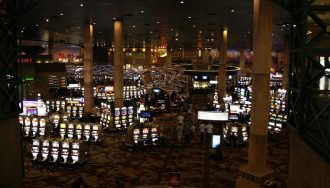The History of Bingo
 History of Bingo
History of Bingo
- History of The Bingo Game
- Bingo Game Origin: A Mysterious History
- Bingo’s Evolution Across Europe
- Bingo Comes to the US
- The Bingo Boom
- The Online Bingo Phenomenon
- A Bingo Decline?
- Frequently Asked Questions
The history of bingo is a long and fascinating one that stretches back many centuries. Bingo’s history spans back hundreds of years, and many historians have traced the bingo game origin all the way back to the 16th century! In this comprehensive guide, we’ll explore the complete history of bingo and the history of the bingo game from the 16th century to the online game we see played today.
History of the Bingo Game
Bingo is one of the most popular and well-known games in the world, enjoyed by millions of people across many countries. While the game is synonymous with church halls and retirement homes today, bingo actually has a long and fascinating history stretching back centuries.
In this comprehensive guide, we’ll explore the origins of bingo, how it evolved over the years, and some of the cultural impacts it has had across different eras and societies. While the game is less popular than before, you’ll still find it at many of the best US online casinos, so be sure to check our recommended sites!
Bingo Game Origin: A Mysterious History
The exact origins of bingo are shrouded in mystery, with multiple theories about where the game first emerged. Some historians trace it back to 16th century Italy, when a lottery-style game called “Lo Giuoco del Lotto D’Italia” became popular. Others believe it has roots in Elizabethan England, where a similar game involved crossing numbers off a card.
There’s also evidence that bingo-style games were played in Germany in the 1800s. A game called “Toten-Bingo” used cards with 9 squares in a 3×3 grid, very similar to modern bingo cards. Players would cover numbers called by the host until one line was complete.
The most common theory is that bingo evolved from the 16th century French game “Le Lotto”, which itself was likely derived from Italian lottery games. Le Lotto cards contained 3 horizontal and 9 vertical rows with a total of 27 squares – very close to the classic 5×5 bingo card.
So, while the exact bingo game origin is unclear, it seems some form of numbered ball drawing game emerged in Europe during the 16th century, gradually evolving over the next few centuries into what we now know as bingo. Today, there are several variations of bingo available. In the table below, we’ll show you a few of the most popular ones:
| Bingo Game | Description |
|---|---|
| 75-Ball Bingo | The classic bingo game uses cards with a 5×5 grid and the middle square marked as “free”. Numbers 1-75 are called. |
| 80-Ball Bingo | Popular UK variant played on 4×4 cards with numbers 1-80 called. Each number corresponds to a different color. |
| 30-Ball Bingo | Fast paced game played on cards with 3×3 grid and numbers 1-30. Originated in Germany. |
| Electronic Bingo | Bingo played on electronic consoles. Players can purchase multiple cards and cards are automatically marked. |
| Online Bingo | Bingo games played on internet bingo sites in chat room settings. Often feature side games between main bingo rounds. Is available at many online gambling websites, including online casinos in New Jersey. |
Bingo’s Evolution Across Europe
Throughout the 17th and 18th centuries, various versions of lottery or numbered ball games spread across Europe. In France it was known as “Le Lotto”, in Germany “Toto” and “Bingo” in Italy. When looking at the true bingo game origin, it’s these time periods most historians actually look to.
Though the rules and cards varied slightly, the core gameplay was the same – players matching called numbers to those on printed cards to complete patterns for prizes. These games were mainly used as educational tools to teach children spelling, animal names, historical dates and more.
In the late 1700s, lecturer Carl Leffler created “Geographisch-Statistisches Lotto”, using playing cards to quiz students on historical dates and geography. Other educators followed, creating educational bingo games focused on different school subjects.
Bingo’s popularity as an educational game continued to grow across Europe throughout the 1800s. Various versions appeared in schools and universities to help engage students and liven up the learning process.
While education was the main use initially, bingo inevitably made its way into taverns and carnivals as a gambling game by the early 20th century. The core gameplay was well suited for wagering, allowing players to bet on completing cards for monetary prizes.
Bingo Comes to the US
Bingo seems to have arrived in North America in 1929, with the first known game taking place in Atlanta, Georgia. It was played using beans as markers, giving it the nickname “beano”.
Beano grew in popularity at traveling carnivals and fairs in the early 1930s. Game operator Edwin S. Lowe attended one such carnival in New York and saw people becoming excited over the game.
According to legend, one excited player accidentally yelled “bingo!” instead of beano, giving Lowe the idea to rename it. Lowe began selling customized bingo game sets under the name to great success.
By 1934, bingo’s popularity had exploded. 10,000 bingo game sets were sold by Lowe and competitors across the country. Churches and charities realized bingo was an excellent fundraiser and soon it was widespread.
Bingo’s growth did not go unnoticed by authorities. Concerns over gambling and organized crime quickly arose. By the 1940s, bingo was banned in several states and municipalities. However, that did little to dampen its popularity.
The Bingo “Boom”
Bingo truly hit the big-time following World War 2. Veterans organizations realized it was an effective means to raise funds and banded together to fight anti-gambling laws. Public perception also shifted in favor of bingo as a “soft” form of gambling.
Legislators came under increasing pressure to legalize bingo, which led to a state-by-state wave of pro-bingo legislation from the 1950s onward. Churches, charities, towns, and Native American tribes all hosted legal charity bingo games.
This legislative green light kicked off a huge bingo boom from the 1960s through the 1980s, a period considered the “Golden Age of Bingo”. Thousands of bingo halls opened across North America to meet surging demand. It became a multi-billion-dollar industry with games hosted almost every night in many communities.
Bingo’s popularity also spread to the UK and other regions during this era. Service clubs like the Royal Canadian Legion hosted weekly games and bingo slots in amusement arcades brought it to the masses in the UK. Television also helped fuel bingo mania with game shows based on the format.
Along with booming mainstream success, professional bingo tournaments also emerged, with players competing for large prizes. The popularity wave crested in the mid-1990s, when an estimated $1.5 billion was spent on bingo annually in North America alone.
The Online Bingo Phenomenon
As the internet gambling revolution kicked off in the early 2000s, bingo was one of the first games to make the jump online. The online bingo origin dates back to around 2001, when the first European bingo sites launched , with North American operations following a few years later.
Online bingo proved hugely popular right out of the gate, offering a convenient way to play anytime. Plus, the chat and community features let players retain the social experience of live bingo halls.
Some operators made big innovations like mini side games between draws and jackpot networks linking thousands of players across many sites for gigantic prizes. This brought many new players into the fold and helped offset land-based declines.
In recent years, bingo on mobile devices has grown exponentially thanks to apps from top operators like Paddy Power Bingo. Being able to play on smartphones allows today’s on-the-go players to enjoy bingo wherever they are.
While overall revenues are still well below the peak years, the online sector has helped stabilize and modernize bingo in the 21st century. An estimated 25% of all bingo play now takes place online, and that number continues to grow steadily. Many online bingo games are combined with online scratch cards to offer faster, more exciting gameplay to punters.
A Bingo Decline?
A variety of factors caused bingo participation to decline after hitting its peak popularity in the 1990s. Changing demographics, new gambling competition, and outdated business practices all contributed.
Many loyal players were aging out and younger generations did not take up the game with the same fervor. Bingo’s fusty and dated reputation compared to exciting new casino games turned off potential new players.
The rapid expansion of casinos, lotteries, and internet gambling also siphoned away players. Bingo could not compete with the convenience, variety and big jackpots offered by these gambling alternatives.
Attempts were made to modernize bingo, such as linking up halls for bigger progressive jackpots and offering electronic bingo machines. However, many operators failed to innovate quickly enough and were slow to take the game online.
By the 2010s, the number of bingo halls and players in most jurisdictions had declined substantially from the heyday of the 1960s-1990s. However, bingo has stabilized as a niche gambling activity with a smaller but still passionate player base.




